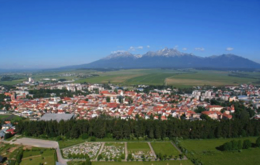This is an old revision of this page, as edited by 94.112.120.81 (talk) at 23:00, 17 January 2009 (→Famous people). The present address (URL) is a permanent link to this revision, which may differ significantly from the current revision.
Revision as of 23:00, 17 January 2009 by 94.112.120.81 (talk) (→Famous people)(diff) ← Previous revision | Latest revision (diff) | Newer revision → (diff)Kežmarok (German: Kesmark/Käsmark, Template:Lang-hu, Template:Lang-pl, Latin: Kesmarkium) is a town in the Spiš region of eastern Slovakia (population 17,000), on the Poprad River.
History
Settlement at Kežmarok dates back to the Upper Stone Age. In the 13th century the region contained a community of Saxons, a Slovak fishing village, a Hungarian border post and a Carpathian German settlement. Its Latin name was first mentioned in 1251 as Villa (Saxonum apud Ecclesiam) Sancte Elisabeth. In 1269 Kežmarok received its town charter. It also had the right to organize a cheese market (hence the German name Kesmark ("Käsemarkt" - "cheese market"). In 1433 the town was severely damaged by a Hussite raid. After 1440, the count of Spiš had a seat in Kežmarok. In the 15th century (and then once more in 1655), Kežmarok became a free royal town.
The town was a stronghold of the noble Thököly family. The Hungarian magnate and warrior Imre Thököly was born in the town in 1657. He died in exile in Turkey in 1705 but in the 20th century his body was returned to Kežmarok and he is buried in a noble mausoleum in the town's Lutheran church.
The town's other monuments include a castle, many Renaissance merchant houses, and a museum of ancient books. In pride of place is the Protestant church built in 1688 entirely of wood. The church also contains an organ of 1719 with wooden pipes. The church has been a UNESCO World Heritage Site since 2008.
Kežmarok had a large ethnic German minority until the end of World War II (see Carpathian Germans). It also had a large and active Jewish community. During World War II, under the auspices of the First Slovak Republic, nearly 3,000 of the town's Jews were deported to German death camps. The town's pre-war Jewish cemetery has now been restored.
Demographics
According to the 2001 census, the town had 17,383 inhabitants. 95.21% of inhabitants were Slovaks, 1.59% Roma, 0.83% Czechs and 0.43% Germans. The religious makeup was 77.50% Roman Catholics, 10.98% people with no religious affiliation, 4.83% Lutherans and 2.63% Greek Catholics.
Twin cities

 Bochnia, Poland
Bochnia, Poland Gliwice, Poland
Gliwice, Poland Hajdúszoboszló, Hungary
Hajdúszoboszló, Hungary Kupiškis, Lithuania
Kupiškis, Lithuania Lanškroun, Czech Republic
Lanškroun, Czech Republic Lesneven, France
Lesneven, France Nowy Targ, Poland
Nowy Targ, Poland Příbram, Czech Republic
Příbram, Czech Republic Weilburg, Germany
Weilburg, Germany Zgierz, Poland
Zgierz, Poland
Famous people
- Vojtech Alexander, radiologist
- Lubos Bartecko, ice hockey player
- Karl Sovanka, painter and sculptor
- Radoslav Suchy, ice hockey player
- Imre Thököly, Prince of Transylvania
- Juraj Herz, film director
References
- ^ "Municipal Statistics". Statistical Office of the Slovak republic. Retrieved 2007-12-15.